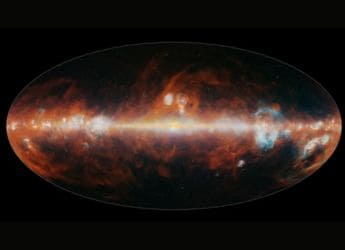- Home
- Science
- Science News
- Perseid Meteor Shower 2025 to Dazzle Night Sky in August
Perseid Meteor Shower 2025 to Dazzle Night Sky in August
The 2025 Perseid meteor shower peaks Aug. 12–13 with up to 100 meteors per hour possible.

Photo Credit: Pixabay/DilanArezzo
The 2025 Perseid meteor shower peaks Aug. 12–13 with up to 100 meteors.
This year's Perseid meteor shower will peak on the night of August 12-13, 2025 with barrage of shooting stars and the possibility of a magnificent fireball sighting. For sky-watchers, it's one of the year's most anticipated meteor events. This yearly event causes the sky to light up with shooting stars when Earth travels through comet 109P/Swift-Tuttle's debris streams. Despite the possibility of fainter meteors being obscured by the 86 percent, lit waning gibbous moon, the strongest streaks should still be visible during the event.
Peak Night and Conditions
According to news sources, the 2025 Perseid meteor shower will reach its peak late on August 12 and into the early morning of Aug. 13. Up to 100 meteors per hour could appear at the peak. However, this year's shower happens to coincide with the rise of a waning gibbous moon, the glare from an 86%-illuminated moon will make it a challenge to spot all but the brightest of meteors.
Experts say only the brightest streaks and occasional fireballs will be clearly visible. Meteor observers may realistically see around 15 meteors per hour during peak conditions. NASA notes that a few “earth-grazing” Perseids could appear as early as 10 p.m. on Aug. 12, though rates will be much higher after midnight.
Viewing Tips and Expectations
Observers should find a dark site. Perseid meteors radiate from the constellation Perseus, near the star Eta Persei in the northeastern sky. Watch between midnight and dawn, especially around 1–5 a.m. local time, when up to 15 meteors per hour may be seen. Keep the moon at your back and face north. Experts stress that peak night is the best time to watch — rates will drop by about half each night after Aug. 13, so waiting for a darker sky is not advised.
Get your daily dose of tech news, reviews, and insights, in under 80 characters on Gadgets 360 Turbo. Connect with fellow tech lovers on our Forum. Follow us on X, Facebook, WhatsApp, Threads and Google News for instant updates. Catch all the action on our YouTube channel.
Related Stories
- Samsung Galaxy Unpacked 2025
- ChatGPT
- Redmi Note 14 Pro+
- iPhone 16
- Apple Vision Pro
- Oneplus 12
- OnePlus Nord CE 3 Lite 5G
- iPhone 13
- Xiaomi 14 Pro
- Oppo Find N3
- Tecno Spark Go (2023)
- Realme V30
- Best Phones Under 25000
- Samsung Galaxy S24 Series
- Cryptocurrency
- iQoo 12
- Samsung Galaxy S24 Ultra
- Giottus
- Samsung Galaxy Z Flip 5
- Apple 'Scary Fast'
- Housefull 5
- GoPro Hero 12 Black Review
- Invincible Season 2
- JioGlass
- HD Ready TV
- Laptop Under 50000
- Smartwatch Under 10000
- Latest Mobile Phones
- Compare Phones
- Huawei Nova 15
- Huawei Nova 15 Pro
- Huawei Nova 15 Ultra
- OnePlus 15R
- Realme Narzo 90x 5G
- Realme Narzo 90 5G
- Vivo S50 Pro Mini
- Vivo S50
- Asus ProArt P16
- MacBook Pro 14-inch (M5, 2025)
- Huawei MatePad 11.5 (2026)
- OnePlus Pad Go 2 (5G)
- OnePlus Watch Lite
- Just Corseca Skywatch Pro
- Acerpure Nitro Z Series 100-inch QLED TV
- Samsung 43 Inch LED Ultra HD (4K) Smart TV (UA43UE81AFULXL)
- Asus ROG Ally
- Nintendo Switch Lite
- Haier 1.6 Ton 5 Star Inverter Split AC (HSU19G-MZAID5BN-INV)
- Haier 1.6 Ton 5 Star Inverter Split AC (HSU19G-MZAIM5BN-INV)
-
 NASA’s SPHEREx Telescope Delivers First Full-Sky Map, Unlocking Cosmic Secrets
NASA’s SPHEREx Telescope Delivers First Full-Sky Map, Unlocking Cosmic Secrets
-
 Robotic Arm Achieves 1,000 Tasks in a Day Through Innovative Imitation Learning
Robotic Arm Achieves 1,000 Tasks in a Day Through Innovative Imitation Learning
-
 Ponies OTT Release Date: Know When to Watch This Emilia Clarke and Haley Lu Richardson starrer web series online
Ponies OTT Release Date: Know When to Watch This Emilia Clarke and Haley Lu Richardson starrer web series online
-
 Bhabhi Ji Ghar Par Hain 2.0 Now Streaming Online: What You Need to Know
Bhabhi Ji Ghar Par Hain 2.0 Now Streaming Online: What You Need to Know












